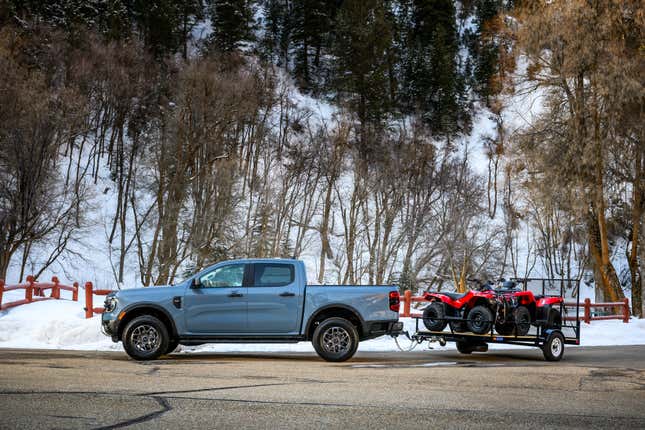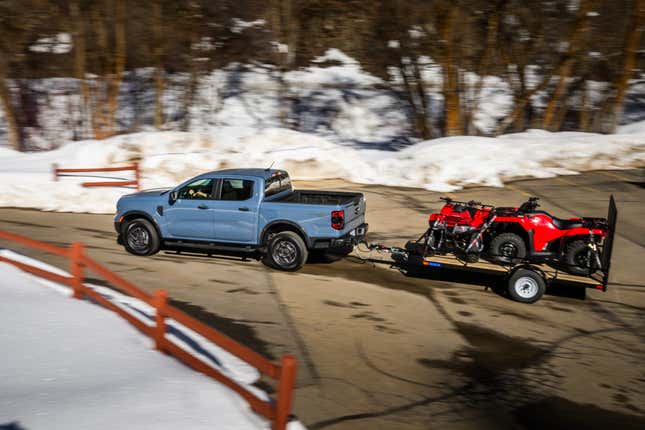First things first, I’m a Ford Ranger guy. I’ve never owned one, and I can’t really point to what it is about the Ranger, maybe just the idea of a Ranger that I love, but I will admit I had high hopes for this one and for the Ranger Raptor, which I will tell you about later this week.
Ford wanted me to come to the Beehive State to check this new 2024 Ranger out. They paid for my flight and lodging and were cool to me the whole time.
The first thing you’ll notice about the new Ranger, probably, is that it’s more upright and trucky than the outgoing one, which owing to its Australian origins had a somewhat more RoW look—to be specific, the hood sloped downward like that of a car, into a more crossover-y grille. That was good for visibility and terrible for looks. The new truck rectifies this, delivering a truck that looks much truckier and much more American.
Moving back along the flank of the thing, you get a nice girdle-tightening character line. Handsome little guy.

Back behind the cab, there’s a little bed. And because this is a Ford, that’s where a bunch of the cute, thoughtful features live. There are big steps (optional) behind the rear tires that’ll support 300lbs. They’re positioned on the side of the truck for packaging reasons and because it provides better access to the bed, even with the tailgate down. The tailgate itself has little recesses for clamps, and the inner edge of it is ruled. There are outlets that can provide 400 Watts of power. And, there are a bunch of LED lights you can activate individually from the Ranger’s touch screen. The idea is that you’d use them to set up camp, or assess a roadkill situation.

Ford’s been on this kick lately of integrating all these little “what if we…?” features into everything it builds, and maybe it’s cute, but it’s also very good. I’d use several of the aforementioned features in ways that would make put Ford’s legal people in the very uncomfortable position of insisting they be banned.
Ford’s Pro Trailer Backup Assist thing is also available here. To use it, you apply a decal to your trailer’s tongue which allows the Ranger’s backup cam to track it, then record some information about the trailer’s dimensions on the touchscreen. Then you can use a little knob, about the size of a can of ZYN, to steer your trailer. You simply turn the dial in the direction you want the trailer to go. I tried it, and if you already know how to back up a trailer, it is effectively another skill to learn. Would I grow to use and love it? Who knows?
The bed is 48.2 inches wide between the wheel wells and 59.6 inches deep. Your plywood sheets will fit back there with the tailgate down. Max available towing is 7,500 LBS, max payload is 1805 LBS, which is about 200 lbs more than Colorado or Tacoma. If you check the box for four-wheel-drive that payload number goes down to 1711, which is still about a hundred pounds better than Colorado and Tacoma.
“Hmm, 48-inches between the wheel wells?” you’re saying. You’re remembering that outgoing Ranger’s bed was 44.8-inches between the wheel wells, meaning that the plywood would NOT fit unless you tilted it on a wheel well. Similarly, drywall sheets would not fit unless you tilted them and get real, they’d break. So how did we get almost four additional inches of width when the truck is pretty dimensionally similar to the outgoing one? (The outgoing frame has been stretched just 2-inches in the wheelbase and 2-inches in width.) Well, one part of it is that they moved the shock mounts outboard, closer to the wheels.

Aside from the plywood thing, this has also made the new Ranger more stable in the rear, especially when there’s nothing back there. If you’ve driven a pickup truck without anything in the back, even a modern pickup, you know how weirdly skittery they can be. Actually, the more modern and comfortable the truck, the weirder it is when you start feeling the rear end of a Model A through heated leather seats whenever you encounter broken pavement. The Ranger doesn’t do that. It’s planted, even if you’re deliberately seeking out broken pavement to test it out.

From the cabin, the Ranger looks feels really modern. Depending on the trim level, you can get decent leather, a premium stereo (fine), a bunch of different screens, its own 4G connection and all the Ford Co-pilot Assist features. There are 360 degree cameras, which are useful because you do give up a little visibility, especially out the windshield, for the sake of that more American-looking hood.
Interior assembly quality on our test trucks was imperfect in spots. If you go looking around for plastic overmoulding misaligned trim, you’ll probably find it. But overall, I thought the interior was attractive, comfortable and usable, though I did lose my navigation to a freeze that required me to turn the car off and back on to reset it and I had a few momentary audio interruptions while using CarPlay. If I were an owner and either of those issues became persistent, I would become the Joker, so to speak. I should note here, that the Rangers I drove were pre-production units. But they’re also the ones they handed to journalists for testing purposes so that caveat can kind of cut both ways.
It’s massively, shockingly quiet inside. There’s tremendous amount of headroom, which can, surprisingly, be an issue in midsize pickups. Crucially, the window is near perfect as a place to rest your elbow while steering.

The steering itself though, is oddly dead. It’s not hard to use, it just feels heavy and remote. In a cabin that’s so car-like and comfy, you can start to expect the driving to be car-like. Not when it comes to the steering, not in the standard Ranger, anyway.
The turbocharged 2.3-liter four is punchy enough at highway speeds, delivering 270 horsepower and 310 pound-feet of torque. There’s a twin-turbo 2.7L V6 coming this summer and I bet it’ll be popular. That one’s good for 315 hp and 400 lb-ft.

There is an FX4 package, but Ford hasn’t said anything about a Ranger that could slot between the regular Rangers and the Raptor as far as off-road capability, there’s no Ranger Tremor at the moment. So, owners who are desperate to start their off-road build will either have to start with a Raptor or order a more pedestrian Ranger with both diff lockers and and figure out their own tires and suspension.
As of now, there’s one body-style, SuperCrew, which is the aforementioned 59.6″ bed, 4-doors and a folding rear seat. Trim levels are XL, XLT, and Lariat and pricing starts at $34,265 and tops out at $45,225 before options.
This 2024 Ranger is probably best thought of as a restyled and heavily evolved version of the outgoing model, rather than a clean sheet rethink. It’s comfortable and practical, and to my eye much better looking now. Ford seems to have found ways big and small to make it more useful. I haven’t driven the current sales king of the mid-size pickups, the Tacoma. I haven’t driven the current Colorado or Pathfinder, either, so unfortunately, I’m not in a position to state a preference.
I did like the Ranger’s styling and I’m a sucker for the little, practical features like the clamp pockets and zone lighting. Ford’s got an opportunity to show us that this Ranger can be the reliable, useful, capable truck that most truck buyers actually need.
I have a deeply embedded memory of dozing in bib overalls and parka, perched on a Ranger’s jump seat and pinched against the window, headed out to a dumb teenage job shoveling roofs for cash at a ski resort. Every time I see Ranger of any vintage, I am warmed by it. Will this one find a place among the beloved Rangers of the past? We’ll see, but it’s got a shot.








